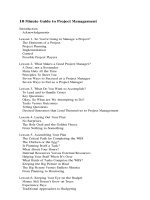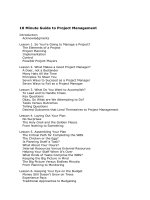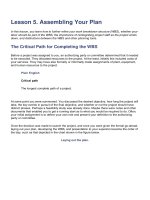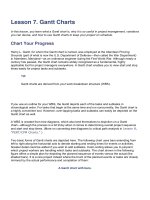Absolute beginners guide to project management
Bạn đang xem bản rút gọn của tài liệu. Xem và tải ngay bản đầy đủ của tài liệu tại đây (17.17 MB, 338 trang )
•
•
I
T
R'B
,
"
Ui
•
J
No prior project management
experience necessary!
ue'
Gre
0
M . Horine
ABSOLUTE
-SEGiNNER'S
GUiDE
CO
Project
Management
Gregory M. Horine
The British Council
P.O. Box 1043
Addis Ababa
\
.~
-1;
"')!~~ f
oue
800 East 96th Street,
Indianapolis, Indiana 46240
Absolute Beginner's Guide to Project
Management
Associate Publisher
Copyright © 2005 by Que Publishing
Acquisitions Editor
All rights reserved. No part of this book shall be reproduced, stored in a
Michael Stephens
Loretta Yates
tocopying, recording, or otherwise, without written permission from the
Development
Editor
publisher. No patent liability is assumed with respect to the use of the
Songlin Qiu
information contained herein. Although every precaution has been taken
Managing Editor
retrieval system, or transmitted by any means, electronic, mechanical, pho-
in the preparation of this book, the publisher and author assume no
Charlotte Clapp
responsibility for errors or omissions. Nor is any liability assumed for damages resulting from the use of the information contained herein.
Project Editor
Dan Knott
International Standard Book Number: 0-7897-3197-5
Library of Congress Catalog Card Number: 2004109550
Printed in the United States of America
07
06
05
Benjamin Berg
Indexer
First Printing: April 2005
08
Production Editor
4
3
2
Trademarks
All terms mentioned in this book that are known to be trademarks or service marks have been appropriately capitalized. Que Publishing cannot
attest to the accuracy of this information. Use of a term in this book
should not be regarded as affecting the validity of any trademark or service mark.
Warning and Disclaimer
Every effort has been made to make this book as complete and as accurate as possible, but no warranty or fitness is implied. The information pro-
Sharon Shock
Proofreader
Suzanne Thomas
Technical Editor
Andrew Cline
Publishing
Coordinator
Cindy Teeters
Interior Designer
Ann Jones
vided is on an "as is" basis. The author and the publisher shall have
Cover Designer
neither liability nor responsibility to any person or entity with respect to
Dan Armstrong
any loss or damages arising from the information contained in this book.
Bulk Sales
Page Layout
Kelly Maish
Que Publishing offers excellent discounts on this book when ordered in quan-
Illustrators
tity for bulk purchases or special sales. For more information, please contact
U.S. Corporate and Government Sales
1-800-382-3419
Craig Thurmond
For sales outside of the U.S., please contact
International Sales
Laura Robbins
Contents at a Glance
Part I
Introduction
1
Project Management Jumpstart
5
1
Project Management Overview
2
The Project Manager
19
3
Essential Elements for Any Successful Project
27
Project Planning
37
Part II
7
4
5
Defining a Project
Planning a Project
6
Developing the Work Breakdown Structure
65
7
Estimating the Work
79
8
9
Developing the Project Schedule
Determining the Project Budget
91
107
Project Control
117
Part III
,
.39
.49
10
Controlling a Project
119
11
12
Managing Project Changes
Managing Project Deliverables
137
151
13
Managing Project Issues
163
14
Managing Project Risks
173
15
Managing Project Quality . ,
187
Project Execution
199
16
Leading a Project
201
17
18
Managing Project Communications
Managing Expectations
213
227
Part IV
19
Keys to Better Project Team Performance
243
20
21
Managing Differences
Managing Vendors
255
267
22
Ending a Project
281
Index
289
,
Table of Contents
Introduction
1
About This Book
1
Who Should Read This Book?
3
How This Book Is Organized
3
Conventions Used in This Book
4
Project Management Jumpstart
1
Project Management Overview
What Is Project Management
2
3
5
7
Exactly?
8
What Is the Value of Project Management?
12
Why Are Projects Challenging?
13
Growing Demand for Effective Project Managers?
15
Trends in Project Management
16
The Project Manager
19
One Title. Many Roles
20
Key Skills of Project Managers
21
Qualities of Successful Project Managers
23
15 Common Mistakes of Project Managers
24
Essential Elements for Any Successful Project
27
What Exactly Is a "Successful" Project?
28
Learning from Troubled Projects
29
Learning from Successful Projects
32
Essential Project Manager Toolkit
33
II Project Planning
37
4
Defining a Project
39
Setting the Stage for Success
40
How Does Defining a Project Relate to Project Planning?
40
Project Definition Document
42
Project Definition Checklist
45
Planning a Project
49
Key Project Planning Principles
50
Important Questions Project Planning Should Answer
52
Building a Project Plan
53
Summary of Supplemental Project Plan Components
60
Project Plan Checklist
62
Developing the Work Breakdown Structure
65
What Is a WBS Exactly?
66
Why Is the WBS Important?
72
The Process of Building a WBS
73
Estimating the Work
79
Next Step in the Schedule Development Process
80
Managing the Risk, Managing the Estimates
82
Reasons for Estimating Woes
82
Powerful Estimating Techniques and Methods
84
Best Practices
86
5
6
7
vi
8
9
ABSOLUTE BEGINNER'S GUIDE TO PROJECT MANAGEMENT
Developing the Project Schedule
91
The Impact of the Project Schedule
92
The Goal of the Schedule Development Process
94
Key Inputs for Building a Schedule
95
Creating a Schedule
96
Determining the Project Budget
107
The Impact of the Project Budget
108
Principles of an Effective Budget
109
Creating a Project Budget
110
Common Budget Challenges
114
III Project Control
10 Controlling a Project
..117
119
What Is Project Control?
120
Management Fundamentals for Project Control
123
Powerful Techniques for Project Control
124
Performance Reporting
127
Variance Responses
129
Leveraging Earned Value Management Concepts
130
Common Project Control Challenges
132
Lessons from Project Recoveries
134
11 Managing Project Changes
137
What Exactly Is a Project Change and What's the Big Deal Anyway? .. 138
Fundamentals for Managing Project Change
141
What Causes Unplanned Scope Changes?
142
Essential Elements of a Project Change Control System
143
Powerful Techniques for Minimizing Project Changes
146
Common Project Change Control Challenges
148
CONTENTS
12 Managing Project Deliverables
151
"Managing Project Deliverables" Means What Exactly?
152
Why Do This? It's Too Much Work
153
Identify, Protect, and Track: The Principles of Managing Work Products 154
Best Practices
155
Configuration Management Plan
159
Common Challenges and Pitfalls
161
13 Managing Project Issues
163
The Goals, Objectives, and Principles of Project Issue Management
164
Key Features of Issue Management System
165
Options for Issue Log
167
Best Practices
168
Some Special Situations
170
14 Managing Project Risks
173
Key Risk Management Principles
174
The Essential Process for Managing Project Risks
175
The Common Sources of Project Risk
178
Typical Problems
182
Powerful Risk Control Strategies
183
Are You Sure It's a Risk?
184
15 Managing Project Quality
187
What Is "Project Quality"?
188
Unique Aspects of Managing Project Quality
189
Principles of Managing Project Quality
189
Powerful Tools and Techniques for Project Quality
191
Powerful Quality Strategies
193
Typical Quality-Related Challenges
194
vii
viii
ABSOLUTE BEGINNER'S GUIDE TO PROJECT MANAGEMENT
IV Project Execution
16 Leading a Project
199
201
More Than Managing
202
Where Is Leadership Needed on a Project?
204
Twelve Keys to Better Project Leadership
206
Power of Servant Leadership Approach
208
17 Managing Project Communications
213
What Are Project Communications?
214
The Importance of Project Communications
215
Why Communicating Can Be Tough
216
Seven Powerful Principles
217
Best Practices of Effective Project Communicators
219
18 Managing Expectations
227
Value of Reviewing Stakeholder Expectation Management
228
Critical Aspects of Expectations
228
Seven Master Principles of Expectation Management
233
Essential Elements of Managing Expectations
235
19 Keys to Better Project Team Performance
243
High-Performing Teams
244
Ten Key Principles
244
Proven Techniques
247
Special Situations
250
20 Managing Differences
255
Five Key Principles
256
Proven Techniques for Leading Cross-Functional Projects
258
Proven Techniques for Leading Cross-Cultural Projects
261
Proven Techniques for Leading Virtual Projects
262
CONTENTS
21 Managing Vendors
267
First, Let's Clarify a Few Terms
268
Ten Proven Principles of Vendor Management
268
Twelve Tips for Buyers
271
Seven Tips for Sellers
273
Twelve Key Project Management Skills for Better Vendor Management 274
Stuff You Need to Know About Contracts
22 Ending a Project
275
281
Three Key Principles
282
Project End Checklist-13 Important Steps
282
Common Project Closing Challenges
284
Methods for Ending a Contract or a Project
285
Index
289
ix
About the Author
Gregory M. Horine is a published author (PMP Exam Cram 2) and certified project
management and business technology professional (PMP, CCP) with more than 16
years of consulting experience across multiple industries. His primary areas of professional expertise include
•
Project management and leadership
•
Complex application development
•
Enterprise solution development
•
Business process analysis and improvement
•
Data analysis and transformation
•
Package implementation and integration
•
Vendor and procurement management
•
Regulatory and process compliance
•
Project management tools
•
Computer systems validation
•
Testing processes
•
Quality and risk management
In addition, Mr. Horine holds a master's degree in computer science from Ball State
University and a bachelor's degree in both marketing and computer science from
Anderson College (Anderson, IN).
Through his "servant leadership" approach, Mr. Horine has established a track
record of empowering his teammates, improving project communications, overcoming technical and political obstacles, and successfully completing projects that meet
the targeted objectives.
Mr. Horine is grateful for the quidcnce and the opportunities that he has received
from many mentors throughout his career. Their patience and influence has resulted
in a rewarding career that has been marked by continuous learning and improvement.
You can access a recent interview of Mr. Horine by the Canadian Information
Processing Society (CIPS) and the Networking Professionals Association (NPA) at
these respective websites:
/>phenibarakLcom/cips/feb04/ghor.asp
When not engaged in professional endeavors, Mr. Horine hones his project management skills at home with his lovely wife, Mayme, and his five incredible children:
Michael, Victoria, Alex, Luke, and Elayna.
Dedication
This book is dedicated to the"students" that I constantly visualized in my mind as I developed this book-the bright and caring family that surround my life, including my wife,
parents, siblings, in-laws, aunts, uncles, cousins, and grandparents.
This book is also dedicated to the parents, families, practitioners, and researchers who are
diligently fighting to rescue children from autism spectrum disorders.
This book is dedicated to my key inspirational sources: my incredible wife, Mayme (I wakeup everyday with a smile in my heart knowing I am married to her), and my "fabulous five"
children: Michael, Victoria, Alex, Luke, and Elayna (each one is a hero to me).
Acknowledgments
I am grateful for the patience, support, and teamwork demonstrated by the following individuals: my editors, Loretta Yates and Songlin Qiu; the entire Que Publishing
team; the management team at INRANGE Consulting Corporation; my project team;
and my parents (Carla and Bud).
I extend a special thanks to my technical editor, Mr. Andrew Cline, for his perspective and insights. It was a pleasure working with you on this venture.
I wish to acknowledge the talents and professionalism of Mr. Craig Thurmond for
his graphical design contributions to this book.
We Want to Hear from You!
As the reader of this book, you are our most important critic and commentator. We
value your opinion and want to know what we're doing right, what we could do better, what areas you'd like to see us publish in, and any other words of wisdom you're
willing to pass our way.
As an associate publisher for Que Publishing, I welcome your comments. You can
email or write me directly to let me know what you did or didn't like about this
book-as well as what we can do to make our books better.
Please note that I cannot helpyou with technical problems related to the topic of this book.
We do have a User Services group, however, where I will forward specific technical questions
related to the book.
When you write, please be sure to include this book's title and author as well as your
name, email address, and phone number. I will carefully review your comments and
share them with the author and editors who worked on the book.
Email:
Mail:
Michael Stephens
Associate Publisher
Que Publishing
800 East 96th Street
Indianapolis, IN 46240 USA
For more information about this book or another Que Publishing title, visit our website at www.quepublishing.com. Type the ISBN (0789731975) or the title of a book in
the Search field to find the page you're looking for.
iNTRODUCTiON
As organizations continue to move toward "project-based" management to get more
done with less resources, and as the demand for effective project managers continues
to grow, more and more individuals find themselves with the "opportunity" to manage projects for the first time.
In an ideal world, every new project manager candidate would complete certified
project management training programs and serve as an apprentice before starting
their first project manager opportunity, but. ..this is the real world. In many cases, a
quicker, more accessible, and more economical alternative is needed to quide this
audience in managing projects successfully the first time.
The Absolute Beginner's Guide to Project Management is intended to provide this alternative with a helpful, fun, and informative style.
About This Book
Let's take a quick review of the objectives and approach of this book.
Objectives
The objectives of this book include the following:
l1li To be an easy-to-use tutorial and reference resource for any person managing
their first project(s)
l1li To teach the key concepts and fundamentals behind the project management
techniques
If these are understood, they can be applied effectively independent of toolset,
environment, or industry
l1li To reduce the "on-the-job" learning curve by sharing the traits of successful
projects and "lessons learned" from less-than-successful projects
l1li To balance the breadth of topics covered with adequate depth in specific
areas to best prepare a new project manager
l1li To review the skills and qualities of effective project managers
Emphasize the importance of project "leadership" versus just project "management"
2
ABSOLUTE BEGINNER'S GUIDE TO PROJECT MANAGEMENT
Approach
Consistent with the Absolute Beginner's Guide series, this book will use a teaching style
to review the essential techniques and skills needed to successfully manage a project.
By "teaching" style, we intend the following:
III A mentoring, coaching style.
III Assumes that the reader does not have previous hands-on experience with
project management.
III Teaches the material as if an instructor were physically present.
III Task-oriented, logically ordered, self-contained lessons (chapters) that can be
read and comprehended in a short period of time (15-30 min).
III Emphasis on understanding the principle behind the technique or practice.
III Teaches the material independent of specific tools and methodologies.
III Teaches the material with the assumption that the reader does not have
access to organizational templates or methodologies.
III Provides a summary map of the main ideas covered at the end of each chapter. Research has shown that this type of "mind-map" approach can drive
better memory recollection when compared to traditional linear summary
approaches.
OUT-Of-SCOPE
The scope of this book is clearly outlined in the table of contents, but as we will cover later,
it is always good to review what is out of scope to ensure understanding of the scope
boundaries. Since the field of project management is extremely broad, and we needed to
draw the line somewhere, this book focuses on the proper management of a single project.
As a result, the following advanced project management subjects are not covered in this
book:
III Program management
III Enterprise portfolio management
III Enterprise resource management
III Advanced project risk management topics
III Advanced project quality management topics
III Advanced project procurement management topics
INTRODUCTION
3
Who Should Read This Book?
The Absolute Beginner's Guide to Project Management is recommended for any person
who fits into one or more of the following categories:
III Individuals unsatisfied with other introductory project management books
III Individuals new to project management, such as
Technologists
Knowledge workers
Students
Functional managers
III Professionals taking first project management assignment, such as
Team leaders
Project coordinators
Project administrators
Project support
Functional managers
III Experienced project managers needing a refresher course
III Experienced project managers with limited formal project management
education
How This Book Is Organized
This book has been divided into four parts:
III Part I, "Project Management [umpstort," sets up the general framework for
our project management discussion and accelerates your project management learning curve, including an insightful review of successful projects and
project managers.
III Part II, "Project Planning," reviews the processes that establish the foundation
for your project.
III Part III, "Project Control," reviews the processes that allow you to effectively
monitor, track, correct, and protect your project's performance.
III Part IV, "Project Execution," reviews the key leadership and people-focused
skills that you need to meet today's business demands.
4
ABSOLUTE BEGINNER'S GUIDE TO PROJECT MANAGEMENT
Conventions Used in This Book
At the beginning of each chapter, you'll find a quick view of the major topics
that will be expounded upon as you read through the material that follows.
II! The end of each chapter provides a list of key points along with a visual sum-
mary map.
II! You will also find several special sidebars used throughout this book:
tip
These boxes highlight specific techniques or recommendations that could be
helpful to most project
managers.
These boxes highlight
specific warnings that
the project manager
should be aware of.
-PROJECT
MANAGEMENT
JUMPSTART
Project Management Overview .,
The Project Manager
7
19
Essential Elements for Any Successful Project ..27
-PROJECT MANAGEMENT
OVERViEW
Since your perceptions surrounding project management will vary
depending upon work experiences, education, industry, and roles, it's
important to establish some "common ground" before we venture
down the road of learning what a project manager must do to be successful in his/her first opportunity.
This chapter provides the" common ground" by clarifying what constitutes project management and why project management is important
to both your future and the future of your organization.
8
ABSOLUTE BEGINNER'S GUIDE TO PROJECT MANAGEMENT
What Is Project Management... Exactly?
If you are like most people, you are "pretty sure" you know what projects are, and
you "think" you know what project management is (and what a project manager
does), but there's always a varying amount of uncertainty in those perceptions. So,
let's start off by clarifying some key concepts. Project management is simply the
process of managing projects (and you thought this was going to be difficult). While
this definition is not particularly helpful, it does illustrate three key points:
• Project management is not "brain surgery." Yes, it covers a vast array of subjects, processes, skills, and tools, but the key fundamentals of project management are straightforward and are consistent across industries.
• To better understand project management, we need to understand what a
project is. The nature of a project provides insights into the scope and challenges of project management.
• To better understand project management, we need to understand what is
implied by the term managing and how this compares against traditional
business management.
What Is a Project Exactly?
A project is the work performed by an organization one time to produce a unique
outcome. By "one time," we mean the work has a definite beginning and a definite
end, and by "unique," we mean the work result is different in one or more ways
from anything the organization has produced before. Examples of projects would
include the following:
• Building a new house
• Developing a new software application
• Performing an assessment of current manufacturing processes
• Creating a new radio commercial
This is in contrast to the operations of an organization. The operational work is the ongoing, repetitive set of activities that sustain the organization.
Examples of ongoing operations include the following:
• Processing customer orders
• Performing accounts receivable and
accounts payable activities
• Executing the daily manufacturing orders
CHAPTER 1
PROJECT MANAGEMENT OVERVIEW
9
To further explain the nature of projects (and project management) and how they
compare to the ongoing operations of an organization, please review the summary
in Table 1.1.
Table 1.1
Comparing Projects and Operations
Feature
Key Similarities
Planned, executed, and controlled
Performed by people
Resource constrained
Planned, executed, and controlled
Performed by people
Resource constrained
Purpose
Attain objectives and terminate
Sustain the organization
Time
Temporary
Definite beginning and end points
Ongoing
Outcome
Unique product, service, or result
Non-unique product, service, or
result
People
Dynamic, temporary teams
formed to meet project needs
Generally not aligned with
organizational structure
Functional teams generally aligned
with organizational structure
Authority of
Manager
Varies by organizational structure
Generally minimal, if any, direct
line authority
Generally formal, direct line
authority
After learning more about the nature of projects, you are beginning to see the inherent challenges involved with project management (and we will detail these out later
in this chapter). For now, let's better define "project management."
IIManaging" Projects
What do we mean when we say "managing" projects?
• We mean applying both the science and art to planning, organizing, implementing, leading, and controlling the work of a project to meet the goals and
objectives of the organization.
• We mean the process of defining a project, developing a plan, executing the
plan, monitoring progress against the plan, overcoming obstacles, managing
risks, and taking corrective actions.
• We mean the process of managing the competing demands and trade-offs
between the desired results of the project (scope, performance, quality) and
the natural constraints of the project (time and cost).
• We mean the process of leading a team that has never worked together
before to accomplish something that has never been done before in a given
amount of time with a limited amount of money.
10
ABSOLUTE BEGINNER'S GUIDE TO PROJECT MANAGEMENT
Sounds like fun, doesn't it? We will explain each of
these key aspects of project management in subsequent chapters, and we will discuss many of the
specific tasks and responsibilities performed by the
project manager in Chapter 2, "The Project
Manager," but for now we just want to align our
general understanding of project management.
An Academic Look
To further assist this alignment process, let's look at
project management from a more academic level.
The Project Management Institute (PMI) defines
project management as a set of five process groups
(refer to Table 1.2) and nine knowledge areas (refer
to Table 1.3).
Table 1.2
Description of Project Management Process Groups
1
Process
Initiating
PMBOK 2000 Edition
Authorizing the project or phase
Common Terms
"preliminary planning"
"kicking off"
2
Planning
Defining and refining objectives of the
project and selecting the best course of action
to attain those objectives
"defining"
"developing the plan"
"setting the stage"
3
Executing
Coordinating the people and resources to
implement the plan
"making it happen"
"getting it done"
"coordinating"
4
Controlling
Ensuring project objectives are met by
monitoring and measuring progress regularly
to identify variances from the plan so that
corrective actions can be taken
"tracking progress"
"keeping on course"
5
Closing
Formalizing acceptance of project or phase
and bringing to an orderly end
"client acceptance"
"transition"
"closeout"
#
Figure 1.1 summarizes the relationships among the project management process
groups, which is based on PMBOK 2004 Edition (Figure 3-2 page 40).
CHAPTER 1
PROJECT MANAGEMENT OVERVIEW
11
FIGURE 1.1
Project management process
relationships.
Table 1.3
#
1
Description of PMBOK Knowledge Areas
Knowledge
Area
Project
Integration
Management
PMBOK 2000 Edition
Processes required to ensure the elements of
the project are properly coordinated
Common Deliverables
Project Charter
Project Plan
Change Requests
Work Results
2
Project Scope
Management
Processes required to ensure that project
includes all the work that is required and
only the work that is required to complete
the project successfully
Scope Statement
Work Breakdown Structure
Formal Acceptance
3
Project Time
Management
Processes required to ensure timely
completion of the project
Network Diagram
Task Estimates
Project Schedule
4
Project Cost
Management
Processes required to ensure the project is
completed within the approved budget
Resource Requirements
Cost Estimates
Project Budget
5
Project Quality
Management
Processes required to ensure the project will
satisfy the needs for which it was undertaken
Quality Management Plan
Checklists
Quality Reviews
6
Project Human
Resources
Management
Processes required to make the most effective
use of the people involved with the project
Role and Responsibility
Matrix
Organization Chart
Performance Evaluations
7
Project
Communications
Management
Processes required to ensure the timely and
appropriate generation, collection,
dissemination, storage, and ultimate
disposition of project information
Communication Plan
Status Reports
Presentations
Lessons Learned
8
Project Risk
Management
Processes concerned with identifying,
analyzing, and responding to project risk.
Risk Management Plan
Risk Response Plan
Risk Log
9
Project
Procurement
Management
Processes required to acquire goods and
services outside the performing organization
Procurement Plan
Statement of Work
Proposals
Contracts
12
ABSOLUTE BEGINNER'S GUIDE TO PROJECT MANAGEMENT
Again, depending on your experiences, you may not
have realized that project management consisted of
all this, and you may not actually perform all of
these activities as a project manager in your organization. However, it is important and helpful to
understand how big your playing field is when
learning something new. This book will not completely educate you on each of these process groups
nor each of the nine knowledge areas, but it will
provide you with the knowledge, essential tools and
"real-world" insights to make you effective in your
first project management opportunity.
What Is the Value of Project
Management?
As operating environment for most organizations
continues to become more global, more competitive,
and more demanding, organizations must adapt. They must become more efficient,
more productive-they must "do more with less." They must continually innovate.
They must respond rapidly to a fast-changing environment. How can they do this?
How can they do this in a strategic manner? How can they do this and still have the proper
management controls? They can do this with effective project management. The
strategic value points that effective project management can offer an organization
include the following:
•
Provides a controlled way to rapidly respond to changing market conditions
and new strategic opportunities
•
Maximizes the innovative and creative capabilities of the organization by
creating environments of focus and open communication
• Allows organization to accomplish more with less costs
• Enables better leverage of both internal and external expertise
•
Provides key information and visibility on project metrics to enable better
management decision-making
•
Increases the pace and level of stakeholder acceptance for any strategic
change
•
Reduces financial losses by "killing off" poor project investments early in
their life cycles









